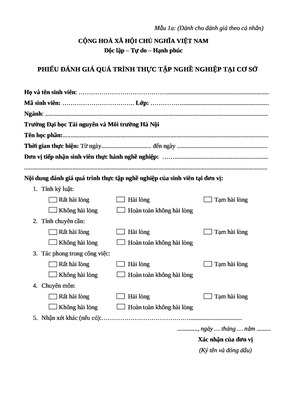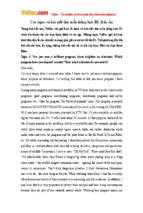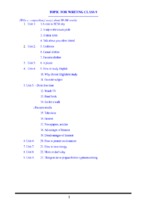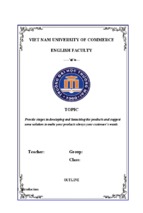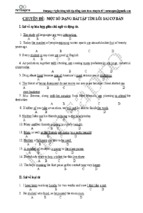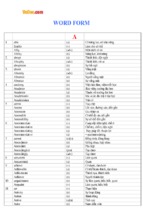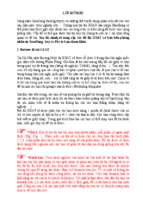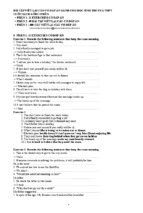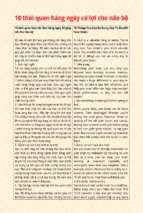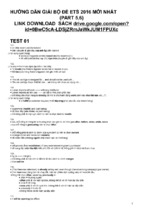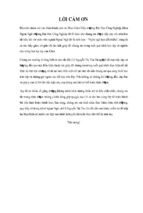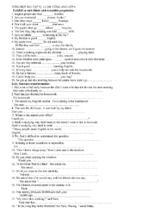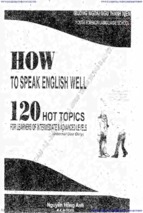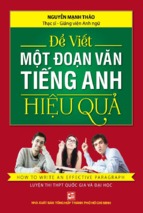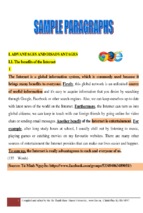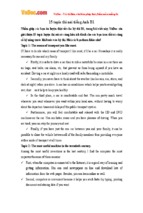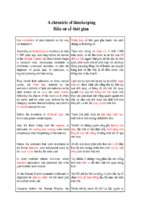& WHITE
Write It Right
WITH STRUNK
celebrating The
Elements of Style 1918-1979
STEVE HIGH &
NAT CRAWFORD
Copyright © Improve Your English Tutoring Services, 2009
This work is licensed under the Creative Commons
Attribution-Noncommercial-No Derivative Works 3.0
United States License. To view a copy of this license,
visit http://creativecommons.org/licenses/by-nc-nd/3.0/us/
or send a letter to Creative Commons,
171 Second Street, Suite 300,
San Francisco, California, 94105, USA.
Contents
Introduction............................................................................................i
The Sentence
Rule 1: Form the possessive singular of nouns by adding ’s...........................1
Rule 2: In a series of three or more terms with a single conjunction,
use a comma after each term except the last........................................1
Rule 3: Enclose parenthetic expressions between commas............................2
When the main clause of a sentence is preceded by
a phrase or a subordinate clause, use a comma to
set off these elements......................................................................................2
Rule 4: Place a comma before a conjunction introducing
an independent clause..............................................................................3
This rule explains how to punctuate compound sentences
and compound predicates.
Rule 5: Do not join independent clauses with a comma.................................4
This rule addresses the comma splice or run-on sentence.
Rule 6: Do not break sentences in two. .............................................................5
This rule addresses sentence fragments of a particular type.
Rule 7: Use a colon after an independent clause
to introduce a list of particulars, an appositive,
an amplification, or an illustrative quotation........................................6
A colon must be preceded by an independent clause.........................................6
Rule 8: Use a dash to set off an abrupt break or interruption
or to announce a long appositive or summary.....................................6
Dashes can also indicate a sudden reversal.....................................................6
Rule 9: The number of the subject determines
the number of the verb. ..........................................................................7
The subject is sometimes some distance from the verb.
Rule 10: Use the proper case of pronoun. ........................................................7
Pronoun Agreement.......................................................................................8
Gender-Neutral Language.............................................................................9
Indefinite Reference........................................................................................9
Rule 11: A participial phrase at the beginning of a sentence
must refer to the grammatical subject.................................................10
The same rule applies to prepositional phrases
and elliptical clauses.....................................................................................10
Rule 12: Choose a suitable design and hold to it............................................10
Rule 13: Make the paragraph the unit of composition..................................11
Rule 14: Use the active voice. ............................................................................11
The passive voice..........................................................................................11
The verb to be............................................................................................12
Rule 15: Put statements in positive form.........................................................12
Rule 16: Use definite, specific, concrete language. .........................................12
This / That / These / Those......................................................................14
Get / Got / Gotten....................................................................................14
Bland Words...............................................................................................14
Similar and Different..................................................................................14
Rule 17: Omit needless words............................................................................15
Avoid the there is construction...................................................................15
Rule 18: Avoid a succession of loose sentences.............................................15
Eleven ways to add variety to a sentence.......................................................16
Rule 19: Express coordinate ideas in similar form.........................................17
This rule addresses parallelism.
Rule 20: Keep related words together..............................................................17
Use the flexibility of adverbial expressions
to keep adjectives and nouns close together.....................................................17
Rule 21: In summaries, keep to one tense........................................................18
Rule 22: Place the emphatic words of a sentence
at the end..................................................................................................19
Style Reminder 4: Write with nouns and verbs.............................................19
Uncover verbs whose action is buried in nouns,
especially with nouns ending in -ion..............................................................20
Do not invent verbs by adding -ize to nouns. ................................................20
How to Write an Essay
1. Limit the subject relentlessly. Divide and subdivide it;
splinter it, and then write about one of the splinters........................21
2. Begin promptly.................................................................................................22
3. Give body to the essay. Consistently develop
one idea....................................................................................................22
4. End when you’re done. Your essay should end
as decisively as it begins.........................................................................22
Types of Paragraphs
INTRODUCTIONS...........................................................................................22
1. Give background on the topic.......................................................................23
2. Describe different points of view on the matter........................................23
3. Discuss the topic in general terms. ...............................................................24
4. Tell a story.........................................................................................................24
CONCLUSIONS.................................................................................................25
1. First, restate thesis in new words, and recap
your argument.........................................................................................25
2. After you have restated your thesis, explain why your
thesis matters...........................................................................................25
Explain some consequences of your thesis’s
being true.................................................................................................25
Issue a call to action...............................................................................25
If you began with an anecdote, you may return to it. ......................26
End with a quote. ...................................................................................26
BODY PARAGRAPHS......................................................................................27
Sample body paragraphs..............................................................................28
WRITING EFFECTIVE PARAGRAPHS.....................................................29
More about Rule 16: Use definite, specific,
concrete language....................................................................................30
Argumentative Paragraphs..........................................................................30
Descriptive Paragraphs................................................................................32
Style Reminder 5: Revise and rewrite.............................................................33
Appendices
Appendix I: Words and Expressions Commonly Misused............................34
Appendix II: Using Verbs Correctly..................................................................35
a. Verb Formation...................................................................................36
b. One Hundred Irregular Verbs..........................................................37
Glossary................................................................................................................... 40
Introduction
Want to improve your English? Write with nouns and verbs, not adjectives and
adverbs. That’s the advice of The Elements of Style, by William Strunk, Jr. and E. B.
White.
White was a professional writer; Strunk was his Cornell English professor. In
part for this reason, professional writers and teachers of English almost universally admire this book. The Associated Press Stylebook, for example, calls Strunk
and White a “bible for writers.” Few students graduate from an American college
without buying at least one copy.
Despite its immense popularity with experts, many beginning writers find Strunk
and White hard to use, rarely take it from their shelves, and privately wonder
what all the heavy breathing is about. The purpose of this booklet is to explain,
illustrate, and send you back to The Elements of Style.
Strunk and White presents 11 rules of usage, 11 rules of composition, and 22
style reminders—hints rather than rules—from E. B. White, one of America’s
most admired stylists. This little book, which in all editions is fewer than 100
pages, makes no pretense to replace authoritative works like the 871-page Chicago
Manual of Style; The Elements of Style covers only a small part of English usage.
Strunk originally wrote it for his introductory writing class at Cornell. He printed
it at his own expense in 1918 and again in 1919, the year E. B. White entered
Cornell. Harcourt Brace published it as a commercial textbook in 1920. Strunk
revised that edition considerably, adding for the first time the essential rule—use
definite, specific, and concrete expressions. In 1934, the publisher brought out
another edition, enlarged and expanded by Strunk’s first and now virtually unknown collaborator, Edward Tenney. After retiring in 1940, Strunk authorized
a reprint of the 1920 edition, omitting the Tenney additions and changes altogether.
In 1959, White produced the edition that gave his old professor undying fame. In
1972, he revised the book again with the help of Eleanor Packard, The New Yorker
copy editor whom he generously acknowledges in that edition. By the release of
the enlarged, expanded, and extensively rewritten third edition of 1979, the book
had become what we know today as Strunk and White. The fourth edition updated examples and discussed removing gender bias. It added a charming foreword
by E. B. White’s son-in-law, Roger Angell; a valuable glossary; and an afterword
by Charles Osgood.
Strunk and White is still as practical, useful, and necessary to the serious writer as
ever. Each line is worth reading and rereading, and all 44 of its numbered recommendations are worth absorbing.
Introduction | i
In 2005, the publishers brought out an illustrated edition with striking and amusing pictures drawn by Maira Kalman. In 2009, an edition commemorating the
50th anniversary of the first Strunk and White edition appeared. These last two
editions, however, made no changes to the text of the fourth edition. While these
versions are pleasant to own, we strongly recommend the fourth-edition paperback, which will fit in your pocket as readily as it does in the pocket of Charles
Osgood.
Both Strunk and White assumed that you had already learned grammar before
you picked up their book. Many of you, however, have not. For this reason, in
this companion volume we have added some basic grammar, notably a table of
irregular verbs; a guide to the correct formation of verb tenses; and a brief discussion of punctuation.
We hope that this booklet is helpful. But our real goal is to get you to pick up
Strunk and White again.
The Elements of Style doesn’t just help you avoid mistakes in your next writing project. It helps you write it right.
STEVE HIGH & NAT CRAWFORD
Introduction | ii
& WHITE
Write It Right
WITH STRUNK
celebrating The
Elements of Style 1918-1979
The Sentence
Rule 1: Form the possessive singular of nouns by adding ’s.
There is an alternative rule (James’ instead of James’s) for singular words ending
in -s. Most editors prefer the Strunk way, but whichever you choose, you must
follow it. You cannot use one rule one time and the other at another time.
In the discussion of this rule, Strunk includes the following admonition:
Do not confuse it’s with its. It’s means “it is.”
When proofreading, mentally expand every “it’s” or “its” into “it is.” This exercise will spare you from condescension, embarrassment, and rejection.
To understand the following principles of sentence structure, learn the following
terms: coordinating conjunctions, subordinating conjunctions, relative pronouns,
conjunctive adverbs, main clause, subordinate clause, and phrase. All these terms are
explained in the glossary.
Rule 2: In a series of three or more terms with a single conjunction,
use a comma after each term except the last.
If you’ve memorized the seven coordinating conjunctions, you can easily spot
the conjunction used as the final link of the three terms below:
We opened the door, walked into the room,
looked around, and admired the house.
Like Rule 1, this practice is not universally followed. The Associated Press Stylebook,
used by all newspapers and many businesses, recommends dropping the comma
before the conjunction in a series. Just make sure that, whichever standard you
follow, you remain consistent. As with Rule 1, you cannot follow the AP guidelines at one point in an essay and Strunk and White at another.
WRITE IT RIGHT | 1
Rule 3: Enclose parenthetic expressions between commas.
Parenthetic expressions provide an extra element of description to the sentence;
the information in such expressions can usually be removed without damaging
the meaning of the sentence. Knowing this rule can help clear up the punctuation of two grammatical structures: appositives and adjective clauses.
Usually, appositives provide parenthetic information about the noun. In the following sentence, an appositive phrase adds extra information about the father.
My dad, a former CIA agent,
speaks English, French, and Thai.
Sometimes appositives provide information essential to identifying a noun. In the
following sentence, we need the appositive to know which cousin is being discussed. Hence, the word is not parenthetic and has no commas surrounding it.
I have two cousins. My cousin Diego
lives in Salt Lake City these days.
Adjective clauses nearly always begin with relative pronouns. If an adjective
clause is not needed to specify a noun, it is a parenthetic expression; separate it
from the sentence with commas.
My father, who worked for the CIA
for many years, owns a lie detector.
Charlie Smith, who used to cook for us,
has just opened his own restaurant.
If an adjective clause is needed to specify a person, place, or thing, it is not a parenthetic expression; do not separate it from the sentence with commas.
The man who opened the door
was my uncle.
We saw two dogs. The dog that had
black spots was rolling on the ground.
The that entry in Strunk and White’s alphabetical listing of “Words and Expressions Commonly Misused” adds to Rule 3.
Rule 3 includes the following point:
When the main clause of a sentence is preceded by a phrase or
a subordinate clause, use a comma to set off these elements.
2
| WRITE IT RIGHT
Here’s an example of an initial phrase:
For three months out of the year,
we stay with my friend in Ohio.
Here’s an example of a subordinate clause beginning a sentence:
Because we needed a place to stay,
we called my friend in the city.
After the publication of the original Elements of Style, some teachers simplified
punctuation by developing a corollary to this rule: if a dependent clause comes at
the end of the sentence, don’t put a comma before it.
We called my friend in the city,
We called my friend in the city
because we needed a place
to stay.
because we needed a place
to stay.
incorrect
correct
Rule 4: Place a comma before a conjunction introducing an independent clause.
This rule explains how to punctuate compound sentences and compound predicates.
If each clause can stand alone, always use a comma before the coordinating conjunction; if only one clause can stand alone, never use a comma. This is a simplification that is always correct.
compound predicate:
He tried everything,
but succeeded at nothing.
He tried everything
but succeeded at nothing.
compound sentence:
He tried everything
but he succeeded at nothing.
incorrect
He tried everything,
but he succeeded at nothing.
correct
WRITE IT RIGHT | 3
Rule 5: Do not join independent clauses with a comma.
This rule addresses the comma splice or run-on sentence. The following sentence is incorrect:
The mouse ran away quickly,
the cat caught it anyway.
Because each half of the sentence could stand by itself as a sentence, it is incorrect to connect the two halves with a comma. You may use a comma plus a coordinating conjunction.
The mouse ran away quickly,
but the cat caught it anyway.
You may also join independent clauses with a semicolon.
The mouse ran away quickly;
the cat caught it anyway.
When you use a semicolon, the material both before and after it must be an independent clause.
Sam put on his hat and walked
out the door; planning his big day.
Sam put on his hat and walked
out the door; he was planning
his big day.
incorrect
correct
You may also show transitions between independent clauses with conjunctive
adverbs.
During the festival, the town choir will sing
at noon. Also, the marching band will perform.
You answered three questions correctly;
however, you must answer four correctly to win.
Surround conjunctive adverbs in the middle of a clause with commas.
George started using better fertilizer.
His plants, consequently, flourished.
The soldiers wanted to go home for the weekend;
the general, however, had other plans.
4
| WRITE IT RIGHT
Remember that commas are delicate little marks. Don’t strew them over your
writing like rock salt on an icy road. Don’t use a comma to separate compound
subjects or compound adverbs.
The players, and coaches
walked slowly, but cheerfully
back to the locker room.
The players and coaches
walked slowly but cheerfully
back to the locker room.
incorrect
correct
Rule 6: Do not break sentences in two.
This rule addresses sentence fragments of a particular type. When you split a
sentence in two—perhaps because you think it’s too long—one of the two pieces
may be a fragment.
If you go to Boston on Saturday.
By itself, this clause is obviously only a piece of a complete sentence, a fragment.
The writer broke it off from a main clause either before or after it and mistakenly punctuated it as a sentence. In context, the fragment may be less apparent:
Be sure to say hello to
your grandparents and give them
my best wishes. If you go to
Boston on Saturday.
incorrect
Be sure to say hello to
your grandparents and give them
my best wishes if you go to
Boston on Saturday.
correct
You can write another kind of incomplete sentence by going on and on without
reaching your destination, a predicate.
The tired soldiers of Company C, exhausted from the long
march and homesick for their loved ones and under relentless fire that seemed endless, in a drenching rainstorm on a
muddy trail winding through mountains and forests.
Such sentences are fragments even though they are not broken off from anything else.
A third type of fragment is the stylistic fragment written deliberately for the sake
of, in Strunk’s phrase, “some compensating merit, attained at the cost of the violation.” Try this on your next school paper. If you feel lucky.
WRITE IT RIGHT | 5
Rule 7: Use a colon after an independent clause to introduce a list
of particulars, an appositive, an amplification, or an illustrative
quotation.
A colon must be preceded by an independent clause.
In the words of John F. Kennedy:
“Ask not what your country
can do for you—ask what you
can do for your country.”
John F. Kennedy said it best:
“Ask not what your country
can do for you—ask what you
can do for your country.”
correct
incorrect
Do not place a colon between a verb and its object or between a preposition and
its object.
We need: pens, paper,
and masking tape.
We need the following supplies:
pens, paper, and masking tape.
We went for a drive
on: Blossom Avenue.
We went for a drive on my
favorite road: Blossom Avenue.
incorrect
correct
Rule 8: Use a dash to set off an abrupt break or interruption or to
announce a long appositive or summary.
The following examples cover the most common use of the dash: setting off appositives that deserve emphasis.
Rupert’s car—a Lotus with a custom apple-green
paint job—was easy to spot.
At length, Eliot received one of the world’s
highest honors—the Nobel Prize.
Dashes can also indicate a sudden reversal.
It was impossible for anyone to escape
the dungeon—and yet he had.
Do not use dashes instead of commas without a reason. For more examples,
consult Strunk and White.
6
| WRITE IT RIGHT
Rule 9: The number of the subject determines the number of the
verb.
The subject is sometimes some distance from the verb. Do not be fooled by intervening material. Strunk and White uses a version of the following example:
The bittersweet flavor of youth—its
trials, its joys, its challenges—are
not soon forgotten.
The bittersweet flavor of youth—its
trials, its joys, its challenges—is not
soon forgotten.
incorrect
correct
You have to spot the subject, flavor, to find the correct form of the verb. An -s at
the end makes the verb singular, but an -s at the end of a noun usually makes it
plural. In most cases, therefore, a subject and verb combination should have exactly one -s between them.
For much more on verbs, see Appendix II.
Rule 10: Use the proper case of pronoun.
Learn to use the correct case, or form, of the nominative, objective, and possessive pronouns (e.g., who, whom, whose; he, him, his).
Pronoun Case
Avoid problems with pronoun case by mentally splitting compound subjects or
objects.
My sister and her missed
the bus.
My sister and she missed
the bus.
My sister and her missed
the bus.
My sister and she missed
the bus.
incorrect
correct
You wouldn’t say “her missed the bus” but rather “she missed the bus.” The following is correct:
My sister and she missed the bus.
WRITE IT RIGHT | 7
The same trick can be applied in the following situation:
The bus almost hit she and I.
The bus almost hit she and I.
The bus almost hit she and I.
The bus almost hit she and I.
The bus almost hit her and me.
The bus almost hit her and me.
The bus almost hit her and me.
correct
incorrect
You wouldn’t say The bus almost hit I, but rather The bus almost hit me. By the same
reasoning, she should become her. The following is correct:
The bus almost hit her and me.
This trick doesn’t work with the common blunder between you and I. Just remember that between you and me is always correct and that the other is always wrong.
Rule 10 does not address pronoun-antecedent agreement although Strunk and
White briefly discusses this issue in the they entry in “Words and Expressions
Commonly Misused.”
Pronoun Agreement
Match singular nouns to singular pronouns, plural nouns to plural pronouns.
incorrect
SINGULAR
When a person hopes for
PLURAL
the best, they often do the worst.
correct
SINGULAR
When a person hopes for
SINGULAR
the best, he or she often does the worst.
PLURAL
When people hope for
PLURAL
the best, they often do the worst.
A single person is obviously not a they; this common but illogical usage may nevertheless some day become acceptable. It is not acceptable yet.
8
| WRITE IT RIGHT
Gender-Neutral Language
Consider these strategies to avoid an awkward overuse of he or she or an unintentional emphasis on the masculine:
Use the plural rather than the singular.
The writer must address
his readers’ concerns.
singular, gender-biased
Writers must address
their readers’ concerns.
plural, gender-neutral
Eliminate the pronoun altogether.
The writer must address
his readers’ concerns.
The writer must address
readers’ concerns.
pronoun,
gender-biased
no pronoun,
gender-neutral
Substitute the second person for the third person.
The writer must address
his readers’ concerns.
third-person,
gender-biased
As a writer, you must
address your readers’
concerns.
second-person,
gender-neutral
(Adapted from Strunk and White,
3rd and 4th eds.)
Indefinite Reference
The pronoun it, like they, also causes problems. Like all pronouns, it requires an
antecedent. However, writers sometimes mistakenly use it without one. Also, a
sentence can sometimes be improved by eliminating the it altogether.
First, check to make sure that it has an antecedent. In the following example, the
writer seems to think that it refers to setting off fireworks. However, that phrase
does not appear in the sentence, so the it has no antecedent.
When people set off fireworks,
it is a way of being patriotic.
incorrect
When people set off fireworks,
they are showing their patriotism.
correct
Notice that the revised sentence replaces a form of to be with an active verb.
WRITE IT RIGHT | 9
Second, check to see if the it can be eliminated.
It is important for us to see the show.
We should see the show.
weak
vigorous
Again, the revised sentence eliminates a form of to be and uses a concrete subject.
These strategies will help you eliminate unnecessary words and make your writing
vigorous.
Rule 11: A participial phrase at the beginning of a sentence must refer to the grammatical subject.
A participial phrase describes an action, but it does not say who or what performs the action. What performs the action of the phrase must appear at the beginning of the main clause. If you neglect this rule, you will produce a dangling
participle, which is often nonsensical.
Pondering the dessert choices,
a slice of cake sounded good to Tim.
Pondering the dessert choices, Tim
thought a slice of cake sounded good.
incorrect
correct
A slice of cake cannot ponder anything.
The same rule applies to prepositional phrases and elliptical clauses.
After opening the box, the present
fell into my lap.
After opening the box, I watched the
present fall into my lap.
incorrect
correct
The present cannot open the box.
If you habitually convert your words into visual images, you will avoid this error
and many more.
Rule 12: Choose a suitable design and hold to it.
Begin each writing job by asking yourself what you are writing. Are you writing
a cookbook? A letter to the editor? A five-paragraph essay? Almost certainly,
someone has written the same kind of thing before, so study some examples before you begin.
A blank sheet of paper is often intimidating. What to write about? Where to start?
Sometimes it’s best to simply start typing. Writing stimulates thinking; you can (and
probably will) later discard the first sentences, paragraphs, or pages you write until
you reach the real first sentence. Unless it’s good, no one will read further.
10
| WRITE IT RIGHT
- Xem thêm -

